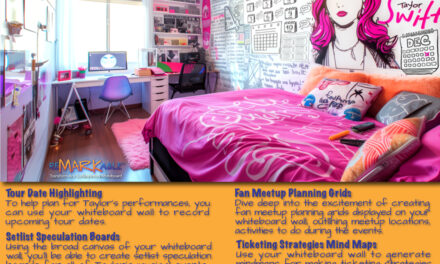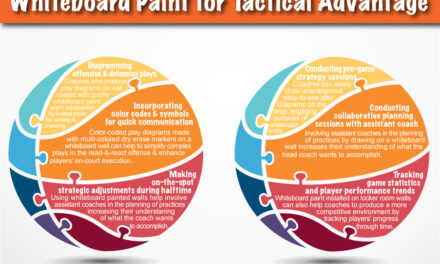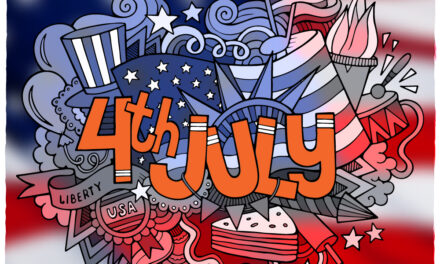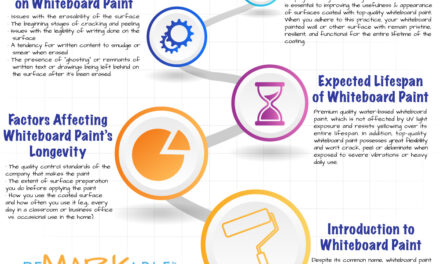Introduction: Our premium Tintable Base Paint should always be your first choice when thinking about an appropriate base coat to apply under our whiteboard coatings because it is specifically formulated to be compatible with these products. However, if you wish to apply an alternate paint as a base coat, a quality satin or eggshell water-based enamel may be used as long as it is free of additives that cause adverse chemical reactions with our coatings.
Using Satin or Eggshell Water-based Enamel as a Base Coat with Whiteboard Paint
We always recommend that customers use our proprietary tintable base paint and primer in one as a base coat, because its formula was developed specifically to be compatible with our high-end whiteboard coatings, and its ingredients will always remain consistent. Whereas the formulas and ingredients of other base paints are subject to occasional changes by manufacturers, so it’s not always possible to know if a particular paint will be suitable as an undercoat for our products. For example, a manufacturer might suddenly start putting additives into their base paints that react poorly with our whiteboard coatings, and this will in turn create problems with the adhesion, sheen, erasability, appearance, and other qualities of your whiteboard painted surface.
So, if you’re planning to use a base coat other than the recommended Remarkable Tintable Base Paint, we suggest that you apply a high-quality satin or eggshell water-based enamel. As far as sheen goes, these types of enamels are in the middle range between being too flat and too glossy, so they can be acceptable base paints for our premium whiteboard coatings without causing problems. Such additives are meant to “breath” and are not compatible when encapsulated or covered with a product that does not allow air to pass through it. Doing so could potentially cause bubbles or create unevenness and irregularities in the finished whiteboard surface and difficulties with writing, erasing, or cleaning
Avoid Flat Paint as a Base with Whiteboard Paint
The reason you should avoid flat paint is that it is highly absorbent. Whiteboard paints such as our top-quality clear and white products are actually special types of coatings and not typical paints. A coating is meant to sit up on top of a surface and not be absorbed down into it as regular paints might be, so when flat paint is used as a base coat the absorbent quality of the flat paint causes the topcoat to be absorbed, thus damaging the ability of the whiteboard coating to stay on the surface and act as a truly durable and impermeable overlay. Hence, the whiteboard surface will have issues such as tiny hills and valleys and certain areas that are too thinly coated, making it difficult to write on, erase, clean, and maintain. In such cases, removing the old coating and recoating with a new layer of whiteboard paint are the only effective ways to relieve the problem.
Avoid Chemicals and Additives with Whiteboard Paint
Avoid base paints that contain additives such as antimicrobial agents, wetting and dispersing agents, defoaming agents, and rheology or flow modifiers. Base paints whose formulas include these types of chemicals, especially in large amounts, can produce adverse chemical reactions when the Remarkable whiteboard coating is applied on top of them. Such additives give off hazardous gases when the whiteboard paint comes into contact with them, creating bubbles which in turn create unevenness and irregularities in the finished whiteboard surface and difficulties with writing, erasing, and cleaning.
Get a Decent Quality Base Paint for Whiteboard Paint
Surface preparation is the most important way to ensure effective adhesion of our quality whiteboard paints. Your preparatory work and your base coat matter a great deal, as they provide a foundation for the durability, usefulness, appearance, and overall quality of your whiteboard coated surface. Preparing the surface begins with making sure that it’s absolutely smooth and even to the touch, so you will need to fill any holes, cracks, and other low areas with spackling compound and then sand the entire surface with 180- to 240-grit sandpaper, depending on its level of roughness. If the wall is of the textured or “orange peel” variety, you should use 180-grit sandpaper to remove all of the rough texture, followed by another sanding with 240-grit paper until perfect smoothness is attained all over. In some situations it may be best to have the wall “floated” out smooth, depending on how much texture there is.
If you have a large wall or several walls to cover with whiteboard paint, using a drywall pole sander can help to greatly speed up the sanding process. A pole sander is a manually operated tool with a long, slim handle that’s used in sanding down sizable surfaces, like walls and floors. By using this tool you can sand more rapidly than if you were sanding with a standard sanding block-type hand sander because much more area can be covered in less time. Otherwise, for a smaller area, you can use a block-type sander.
After you have finished sanding the entire surface and it’s perfectly smooth all around, thoroughly wipe it down by hand with a microfiber cloth or with the pole sander and a microfiber prior to installing our tintable base paint/primer or other base coat, making sure that the surface is fully dry and free of dust and all other types of foreign material such as lint or wood splinters. This is a vital step in the prepping process because, for any type of paint or coating, dust is the major foe of effective adhesion. So, after sanding, the next step in a successful whiteboard paint installation is a thorough cleaning with a microfiber cloth, towel, or mitt. The performance of our premium whiteboard coating is greatly affected by its capacity to adhere well to the substrate, and the presence of even small amounts of surface dust or other debris can significantly reduce the coating’s ability to bond properly to your surface.
Also, make sure that the area where you plan to install the whiteboard paint is accurately taped off with painter’s tape on all appropriate sides. Painter’s tape is recommended over regular masking tape for this job because it’s easier to apply and remove. Both types of tape have a crepe paper backing, but to prevent splitting painter’s tape is usually manufactured with a sturdier type of backing than that of general-use masking tape. This backing also makes painter’s tape easier to remove in a single strip after painting. Also, painter’s tape is specifically designed for use in applying paint or coatings and so does not wrinkle or warp when in the presence of these products, leaving behind clean lines even after several days of being in place.
As with our whiteboard coating, it’s important to avoid having any dust or dirt on the surfaces where you apply the painter’s tape. So, before you begin to tape off the area to be coated, you’ll need to carefully clean the moldings or other areas to which you’re applying the tape. A thorough wiping with a moist microfiber cloth is all that’s usually needed for cleaning. But if the surface is really dirty, you’ll have to wash it off with a microfiber cloth, an eco-friendly phosphate-free detergent, and water. Then wait for the surface to completely dry before starting to apply the tape.
As mentioned above regarding your base coat, if you plan to use a product other than our proprietary ReMARKable Tintable Base Paint, make sure to choose a high-quality satin or eggshell water-based enamel that contains none of the additives listed in item four of the FAQ section on our official website. Two products that we recommend using are the satin finish version of either Sherwin Williams Super Paint, which has great durability, or Benjamin Moore Regal.
Avoid Polyvinyl Acetate in Your Base Coat When Using Whiteboard Paint
Make sure that the base paint you choose does not contain the chemical compound polyvinyl acetate (PVAc), which is a common ingredient in some lower-quality and/or less expensive paints on the market, such as latex wall paints. This compound can have negative chemical reactions with our whiteboard coatings, and can in turn cause problems with the appearance, writability, and erasability of your finished whiteboard surface.

























































































![ReMARKable’s Winter Sale is Here! [25% Off + Free Shipping]](https://www.remarkablecoating.com/wp-content/uploads/2018/01/Red-Tag-Winter-Fashion-Facebook-Post-1-440x264.png)















![Drive Your Organization Into Openness and Watch it Expand [20% Off Whiteboard Paint]](https://www.remarkablecoating.com/wp-content/uploads/2016/04/Drive-Your-Organization-Into-Openness-and-Watch-It-Expand.-1-440x264.jpg)

![30% Off St Patrick’s Day Sale! [Details Inside]](https://www.remarkablecoating.com/wp-content/uploads/2016/03/Glorious-1-440x264.png)


![Giant Leaps Forward Require Big Spaces. [Leap Year Sale Event!]](https://www.remarkablecoating.com/wp-content/uploads/2016/02/Giant-Leaps-ForwardRequire-Big-Spaces-440x264.jpg)

















![ReMARKable Summer Sale 2018 [28% Off Whiteboard Paint]](https://www.remarkablecoating.com/wp-content/uploads/2018/06/Blue-Simple-Line-Beach-Facebook-Post-1-440x264.png)




































































































































































































0 Comments